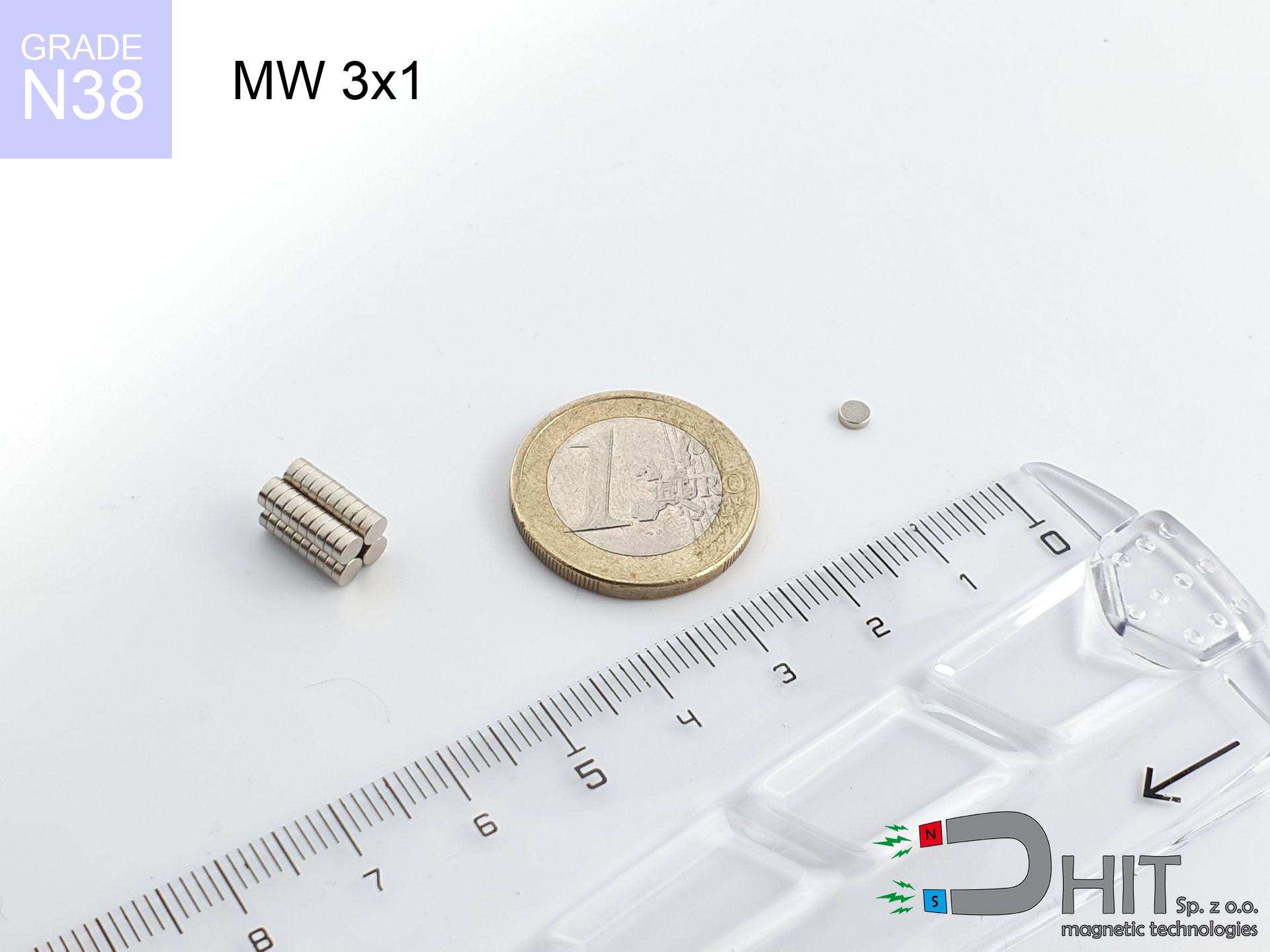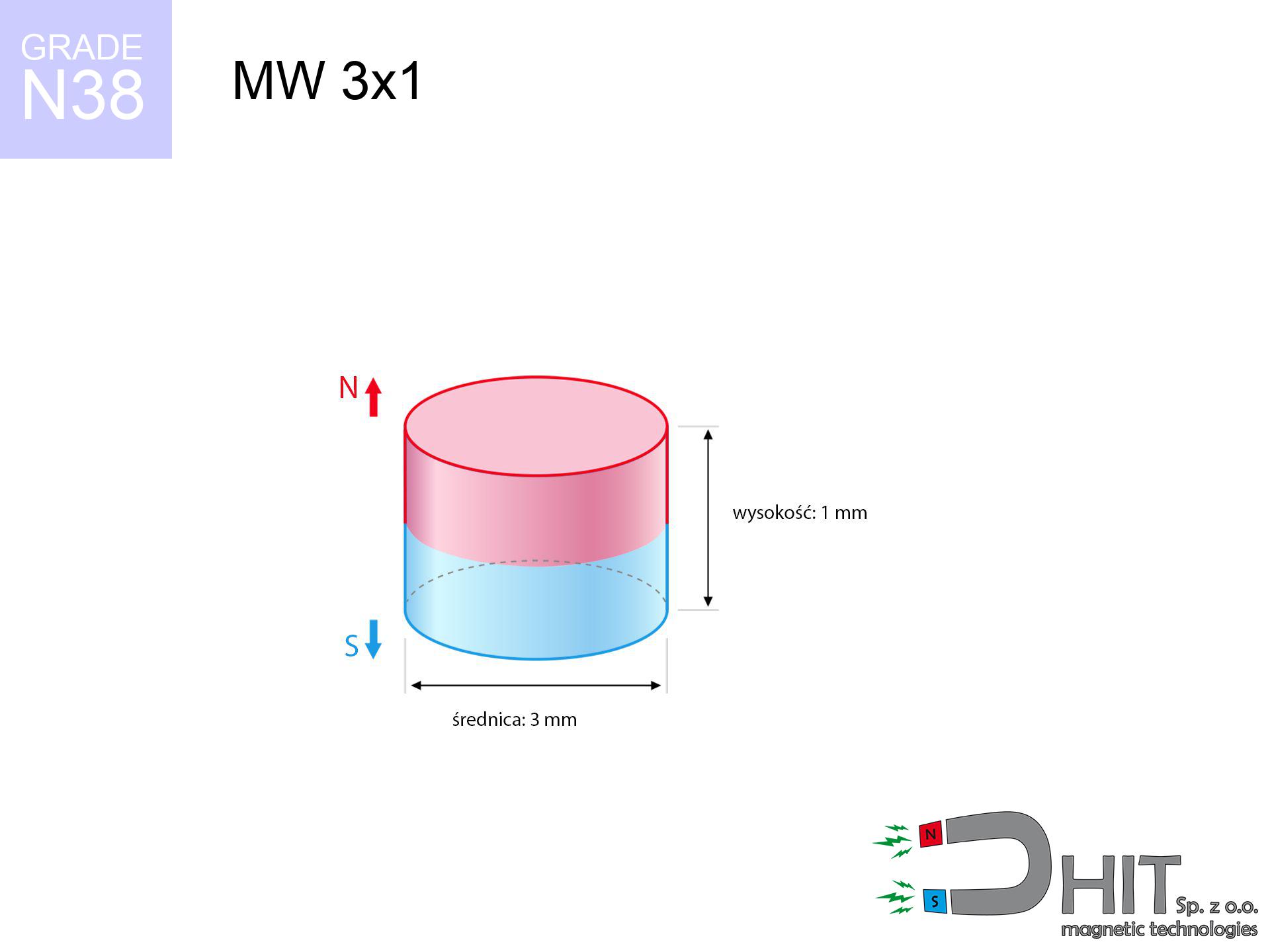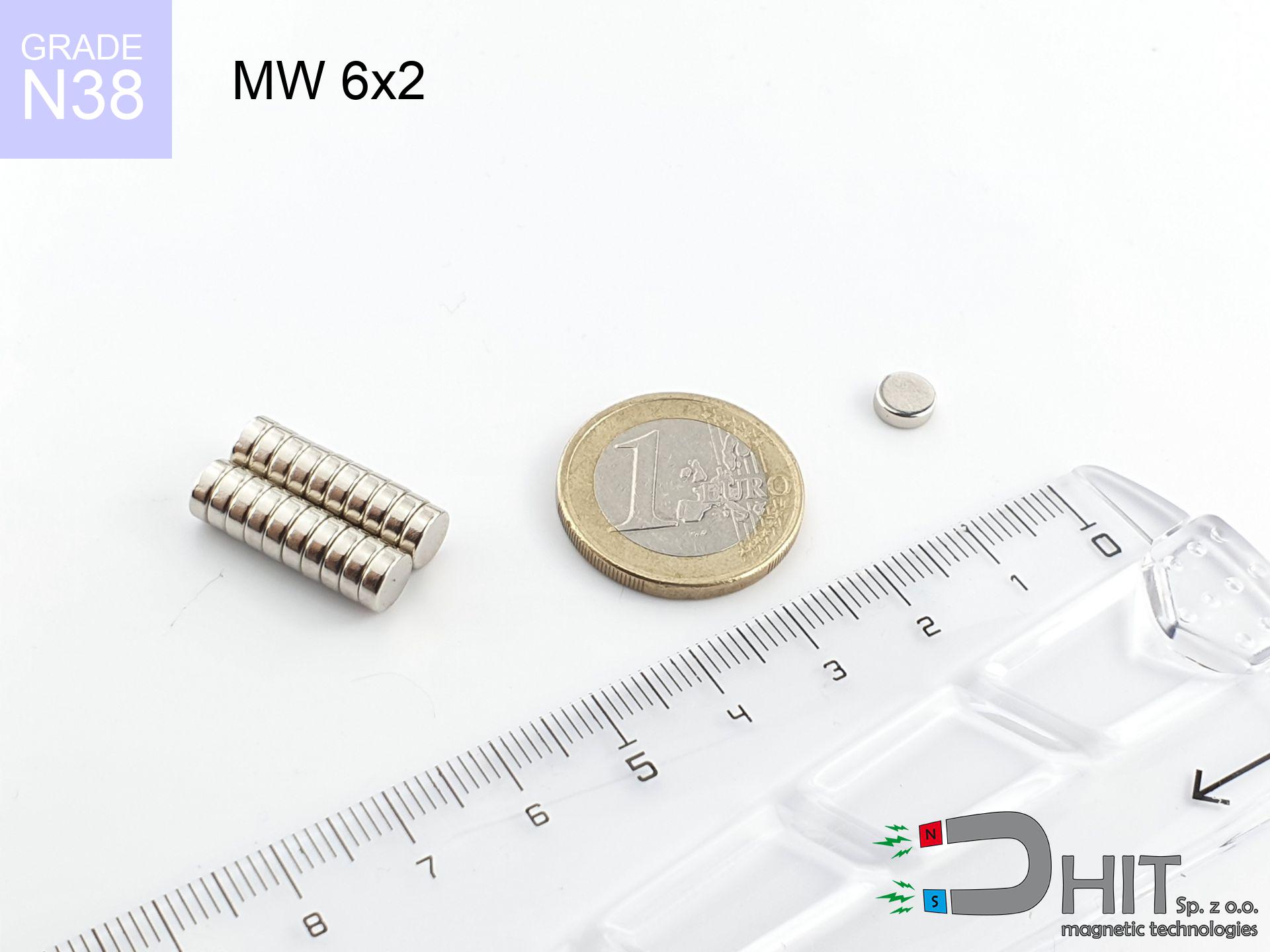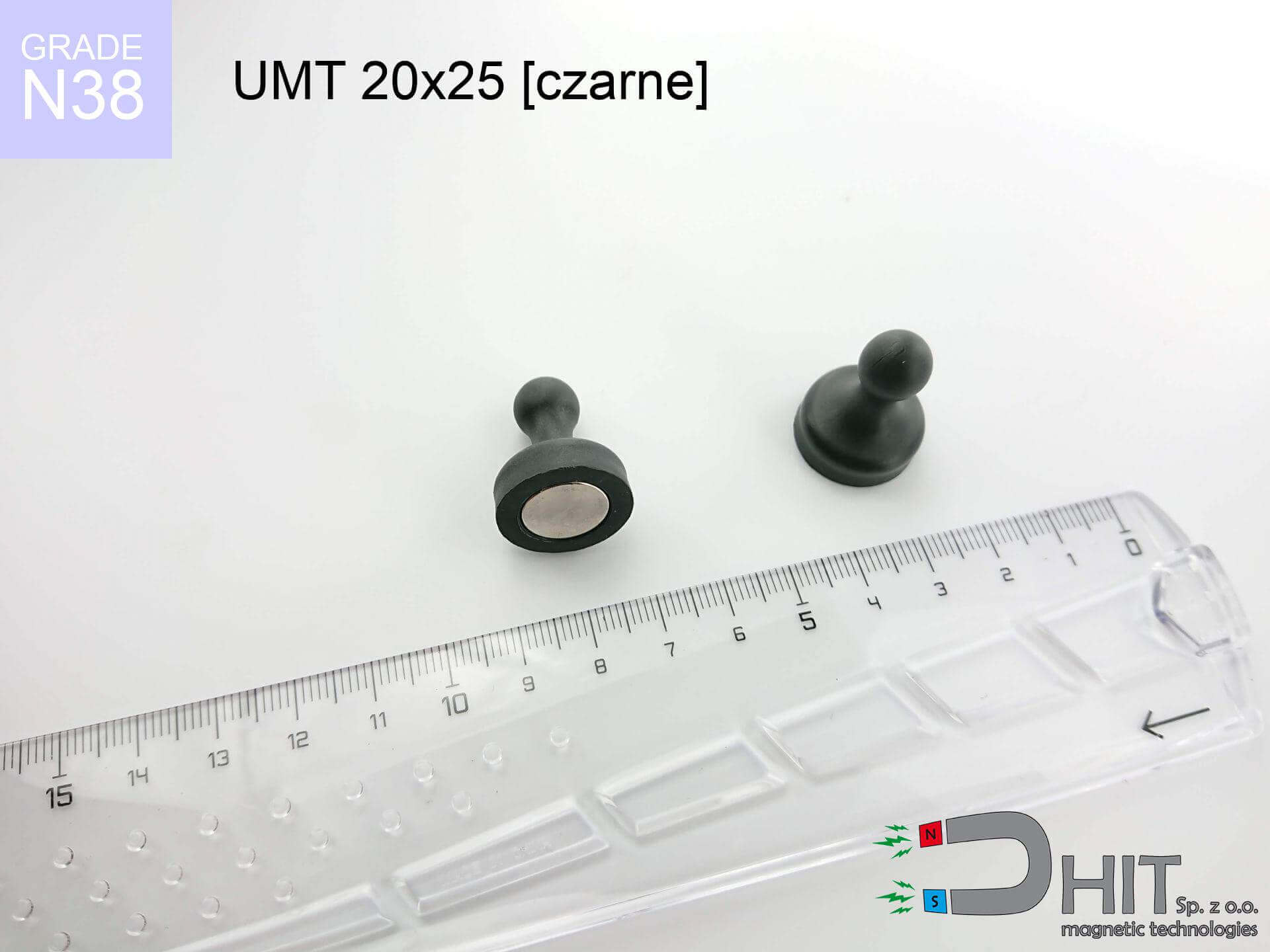MW 3x1 / N38 - cylindrical magnet
cylindrical magnet
Catalog no 010063
GTIN: 5906301810629
Diameter Ø
3 mm [±0,1 mm]
Height
1 mm [±0,1 mm]
Weight
0.05 g
Magnetization Direction
↑ axial
Load capacity
0.17 kg / 1.67 N
Magnetic Induction
342.82 mT
Coating
[NiCuNi] nickel
0.1353 ZŁ with VAT / pcs + price for transport
0.1100 ZŁ net + 23% VAT / pcs
bulk discounts:
Need more?Want to negotiate?
Call us now
+48 22 499 98 98
or drop us a message by means of
our online form
the contact section.
Specifications as well as shape of neodymium magnets can be tested using our
online calculation tool.
Order by 14:00 and we’ll ship today!
Magnetic properties of material N38
Physical properties of sintered neodymium magnets Nd2Fe14B at 20°C
Shopping tips
Strengths as well as weaknesses of NdFeB magnets.
Besides their tremendous magnetic power, neodymium magnets offer the following advantages:
- They virtually do not lose power, because even after ten years the decline in efficiency is only ~1% (according to literature),
- Magnets effectively defend themselves against demagnetization caused by foreign field sources,
- By applying a reflective coating of silver, the element presents an nice look,
- Neodymium magnets achieve maximum magnetic induction on a their surface, which increases force concentration,
- Through (adequate) combination of ingredients, they can achieve high thermal resistance, allowing for operation at temperatures approaching 230°C and above...
- Possibility of exact modeling and adjusting to concrete conditions,
- Versatile presence in modern industrial fields – they serve a role in HDD drives, electromotive mechanisms, advanced medical instruments, also technologically advanced constructions.
- Compactness – despite small sizes they provide effective action, making them ideal for precision applications
Disadvantages of NdFeB magnets:
- To avoid cracks under impact, we suggest using special steel holders. Such a solution protects the magnet and simultaneously increases its durability.
- NdFeB magnets lose force when exposed to high temperatures. After reaching 80°C, many of them experience permanent weakening of strength (a factor is the shape and dimensions of the magnet). We offer magnets specially adapted to work at temperatures up to 230°C marked [AH], which are very resistant to heat
- When exposed to humidity, magnets usually rust. For applications outside, it is recommended to use protective magnets, such as those in rubber or plastics, which prevent oxidation as well as corrosion.
- We suggest casing - magnetic mount, due to difficulties in creating nuts inside the magnet and complex shapes.
- Potential hazard related to microscopic parts of magnets can be dangerous, in case of ingestion, which becomes key in the context of child health protection. Furthermore, tiny parts of these products can complicate diagnosis medical after entering the body.
- High unit price – neodymium magnets cost more than other types of magnets (e.g. ferrite), which increases costs of application in large quantities
Breakaway strength of the magnet in ideal conditions – what contributes to it?
Information about lifting capacity was determined for ideal contact conditions, taking into account:
- with the application of a yoke made of special test steel, ensuring full magnetic saturation
- possessing a thickness of minimum 10 mm to avoid saturation
- with a surface perfectly flat
- with direct contact (no impurities)
- under perpendicular application of breakaway force (90-degree angle)
- at temperature room level
Determinants of practical lifting force of a magnet
In practice, the actual holding force results from several key aspects, presented from most significant:
- Distance (between the magnet and the plate), since even a microscopic clearance (e.g. 0.5 mm) results in a reduction in lifting capacity by up to 50% (this also applies to paint, rust or debris).
- Pull-off angle – note that the magnet holds strongest perpendicularly. Under shear forces, the holding force drops significantly, often to levels of 20-30% of the nominal value.
- Element thickness – to utilize 100% power, the steel must be adequately massive. Thin sheet restricts the attraction force (the magnet "punches through" it).
- Metal type – not every steel reacts the same. High carbon content weaken the attraction effect.
- Base smoothness – the smoother and more polished the surface, the better the adhesion and higher the lifting capacity. Unevenness acts like micro-gaps.
- Temperature – heating the magnet causes a temporary drop of induction. Check the thermal limit for a given model.
* Lifting capacity was measured with the use of a polished steel plate of optimal thickness (min. 20 mm), under perpendicular detachment force, in contrast under attempts to slide the magnet the holding force is lower. Moreover, even a slight gap {between} the magnet’s surface and the plate reduces the holding force.
Precautions when working with NdFeB magnets
Do not overheat magnets
Control the heat. Heating the magnet to high heat will ruin its properties and pulling force.
Respect the power
Be careful. Neodymium magnets attract from a long distance and snap with huge force, often faster than you can move away.
Product not for children
Adult use only. Tiny parts pose a choking risk, leading to intestinal necrosis. Store out of reach of kids and pets.
Dust explosion hazard
Mechanical processing of neodymium magnets poses a fire risk. Neodymium dust reacts violently with oxygen and is difficult to extinguish.
Skin irritation risks
Medical facts indicate that nickel (the usual finish) is a common allergen. If your skin reacts to metals, prevent direct skin contact and select versions in plastic housing.
Fragile material
NdFeB magnets are sintered ceramics, meaning they are fragile like glass. Collision of two magnets leads to them shattering into shards.
Protect data
Do not bring magnets near a purse, laptop, or screen. The magnetism can destroy these devices and wipe information from cards.
Crushing risk
Large magnets can smash fingers instantly. Never put your hand betwixt two strong magnets.
Magnetic interference
Navigation devices and smartphones are highly susceptible to magnetism. Close proximity with a strong magnet can permanently damage the internal compass in your phone.
Pacemakers
People with a pacemaker should maintain an safe separation from magnets. The magnetism can stop the functioning of the life-saving device.
Important!
Looking for details? Read our article: Are neodymium magnets dangerous?






![SM 32x100 [2xM8] / N42 - magnetic separator SM 32x100 [2xM8] / N42 - magnetic separator](https://cdn3.dhit.pl/graphics/products/sm-32x100-2xm8-cox.jpg)


